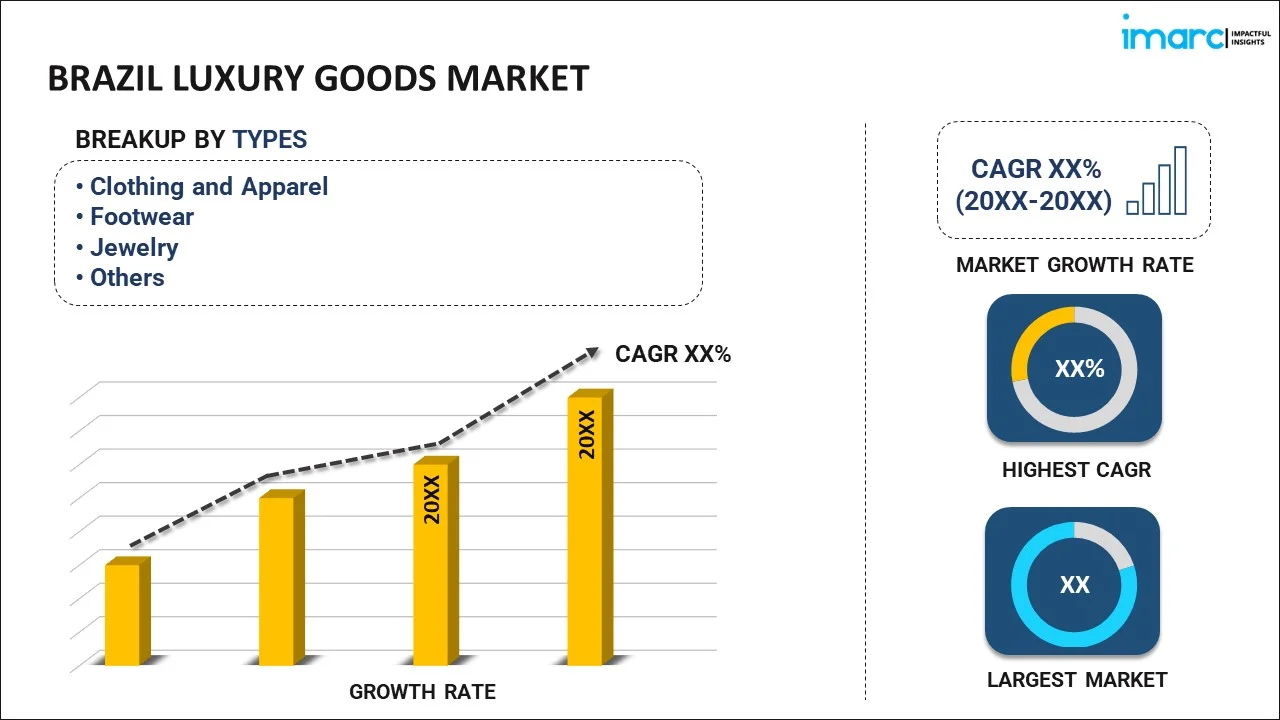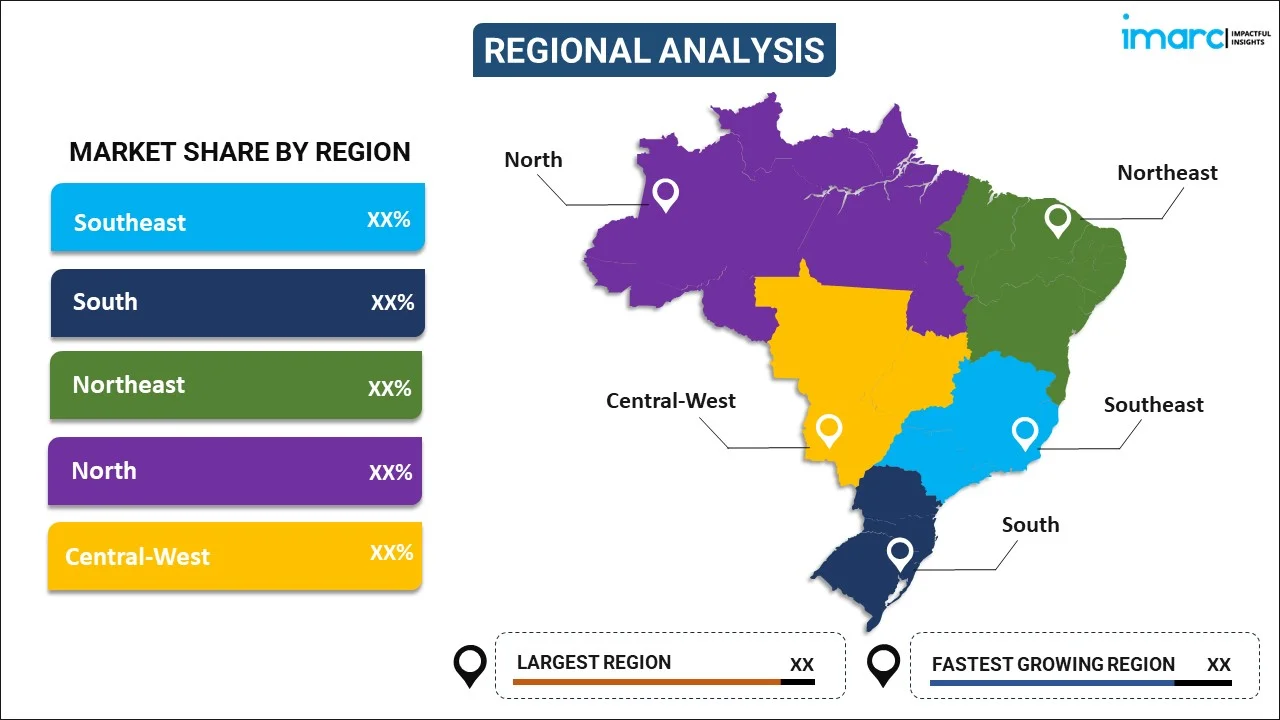
Brazil Luxury Goods Market Report by Type (Clothing and Apparel, Footwear, Jewelry, Watches, Bags, and Others), Distribution Channel (Single-Brands Stores, Multi-Brand Stores, Online Stores, and Others), and Region 2024-2032
Market Overview:
Brazil luxury goods market size is projected to exhibit a growth rate (CAGR) of 4.07% during 2024-2032. The improving economic conditions of the masses, cultural significance of luxury items, rapidly growing tourism industry, strong presence of global luxury brands, rapid growth of the e-commerce and digitalization, and increasing investments in infrastructure represent some of the key factors driving the market.
|
Report Attribute
|
Key Statistics
|
|---|---|
|
Base Year
|
2023 |
|
Forecast Years
|
2024-2032 |
|
Historical Years
|
2018-2023
|
| Market Growth Rate (2024-2032) | 4.07% |
Luxury goods are products or items that are associated with exceptional quality, exclusivity, and prestige. These items often go beyond basic functionality to offer a level of craftsmanship, design, and materials that set them apart from mass-produced alternatives. Luxury goods encompass a wide range of categories, including fashion, accessories, automobiles, watches, jewelry, and more. The distinguishing factor in luxury goods is their price and the intangible value they bring to their owners. Owning a luxury item can signify social status, success, and a penchant for the finer things in life. Brands renowned for producing luxury goods often have a rich history, a commitment to superior craftsmanship, and a loyal clientele who value the experience of owning and using their products.
Brazil Luxury Goods Market Trends:
Brazil has experienced periods of economic growth and rising incomes over the years. A growing middle class and increasing disposable income levels have enabled more consumers to afford luxury products. This economic prosperity is a significant driver of demand for luxury goods. Additionally, luxury items hold cultural significance in Brazil. They are often associated with status, success, and prestige. The Brazilian culture places a strong emphasis on appearances and the display of wealth, making luxury goods highly desirable. Other than this, Brazil is a popular tourist destination, attracting visitors from around the world. Tourists often seek luxury experiences and products, such as designer fashion, high-end watches, and luxury accommodations. This influx of tourists contributes significantly to the luxury market. Besides this, numerous international luxury brands have a strong presence in Brazil. These brands leverage their global recognition and reputation to cater to the Brazilian market. Their established luxury boutiques and stores attract affluent consumers. Other than this, the growth of E-commerce and digital platforms has made luxury goods more accessible to a broader audience in Brazil. Consumers can browse and purchase luxury items online, expanding the market reach of luxury brands. Besides this, Brazil also has expanding luxury fashion and design industry. Local designers are gaining recognition for their unique creations, which often incorporate Brazilian cultural elements. This contributes to the growth of the domestic luxury market. In line with this, as more Brazilians move to urban areas, there is a greater demand for luxury products associated with urban lifestyles. This includes luxury apartments, upscale dining experiences, and luxury vehicles. Moreover, improvements in infrastructure, such as luxury shopping malls and high-end hotels, provide a conducive environment for luxury brands to establish a strong presence and attract affluent consumers.
Brazil Luxury Goods Market Segmentation:
IMARC Group provides an analysis of the key trends in each segment of the market, along with forecasts at the country level for 2024-2032. Our report has categorized the market based on type and distribution channel.
Type Insights:

- Clothing and Apparel
- Footwear
- Jewelry
- Watches
- Bags
- Others
The report has provided a detailed breakup and analysis of the market based on the type. This includes clothing and apparel, footwear, jewelry, watches, bags, and others.
Distribution Channel Insights:
- Single-Brands Stores
- Multi-Brand Stores
- Online Stores
- Others
A detailed breakup and analysis of the market based on the distribution channel have also been provided in the report. This includes single-brands stores, multi-brand stores, online stores, and others.
Regional Insights:

- Southeast
- South
- Northeast
- North
- Central-West
The report has also provided a comprehensive analysis of all the major regional markets, which include Southeast, South, Northeast, North, and Central-West.
Competitive Landscape:
The market research report has also provided a comprehensive analysis of the competitive landscape in the market. Competitive analysis such as market structure, key player positioning, top winning strategies, competitive dashboard, and company evaluation quadrant has been covered in the report. Also, detailed profiles of all major companies have been provided.
Brazil Luxury Goods Market Report Coverage:
| Report Features | Details |
|---|---|
| Base Year of the Analysis | 2023 |
| Historical Period | 2018-2023 |
| Forecast Period | 2024-2032 |
| Units | US$ Billion |
| Scope of the Report | Exploration of Historical and Forecast Trends, Industry Catalysts and Challenges, Segment-Wise Historical and Predictive Market Assessment:
|
| Types Covered | Clothing and Apparel, Footwear, Jewelry, Watches, Bags, Others |
| Distribution Channels Covered | Single-Brands Stores, Multi-Brand Stores, Online Stores, Others |
| Regions Covered | Southeast, South, Northeast, North, Central-West |
| Customization Scope | 10% Free Customization |
| Report Price and Purchase Option | Single User License: US$ 3699 Five User License: US$ 4699 Corporate License: US$ 5699 |
| Post-Sale Analyst Support | 10-12 Weeks |
| Delivery Format | PDF and Excel through Email (We can also provide the editable version of the report in PPT/Word format on special request) |
Key Questions Answered in This Report:
- How has the Brazil luxury goods market performed so far and how will it perform in the coming years?
- What has been the impact of COVID-19 on the Brazil luxury goods market?
- What is the breakup of the Brazil luxury goods market on the basis of type?
- What is the breakup of the Brazil luxury goods market on the basis of distribution channel?
- What are the various stages in the value chain of the Brazil luxury goods market?
- What are the key driving factors and challenges in the Brazil luxury goods?
- What is the structure of the Brazil luxury goods market and who are the key players?
- What is the degree of competition in the Brazil luxury goods market?
Key Benefits for Stakeholders:
- IMARC’s industry report offers a comprehensive quantitative analysis of various market segments, historical and current market trends, market forecasts, and dynamics of the Brazil luxury goods market from 2018-2032.
- The research report provides the latest information on the market drivers, challenges, and opportunities in the Brazil luxury goods market.
- Porter's five forces analysis assist stakeholders in assessing the impact of new entrants, competitive rivalry, supplier power, buyer power, and the threat of substitution. It helps stakeholders to analyze the level of competition within the Brazil luxury goods industry and its attractiveness.
- Competitive landscape allows stakeholders to understand their competitive environment and provides an insight into the current positions of key players in the market.
Need more help?
- Speak to our experienced analysts for insights on the current market scenarios.
- Include additional segments and countries to customize the report as per your requirement.
- Gain an unparalleled competitive advantage in your domain by understanding how to utilize the report and positively impacting your operations and revenue.
- For further assistance, please connect with our analysts.
 Inquire Before Buying
Inquire Before Buying
 Speak to an Analyst
Speak to an Analyst
 Request Brochure
Request Brochure
 Request Customization
Request Customization




.webp)




.webp)












